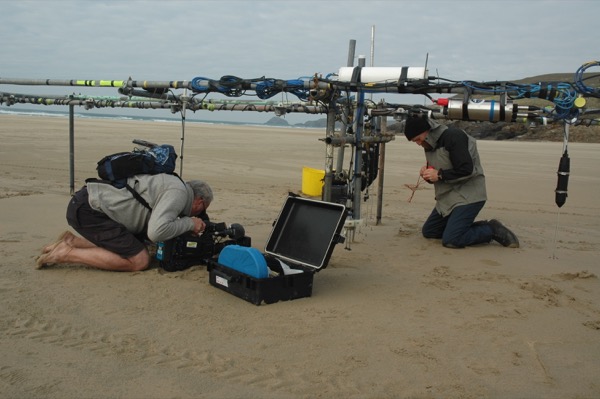
Munitions mysteries
Research to address mobility of unexploded ordnance on beaches
9:14 a.m., Sept. 23, 2015--Hidden dangers on America’s beaches include not only much-publicized shark attacks and rip currents but also unexploded ordnance, a term used to describe undetonated explosives including bombs, shells, grenades and mines.
Artifacts of war, these devices still pose a risk of detonation decades after being used or discarded.
Research Stories
Chronic wounds
Prof. Heck's legacy
The U.S. Army Corps of Engineers has identified more than 400 locations within formerly used defense sites that contain unexploded ordnance in underwater environments, and munitions have been found on beaches from Assateague Island, Maryland, to Hapuna Beach, Hawaii.
A major problem is that no one knows when or where munitions may wash ashore or what happens if they do.
Jack Puleo, associate professor in the Department of Civil and Environmental Engineering at the University of Delaware, has received a $1 million grant from the Department of Defense (DOD) to help figure that out.
The objective of the four-year project, which is funded through the DOD’s Strategic Environmental Research and Development Program (SERDP), is to quantify the small-scale processes on the beach face responsible for munitions mobility, including transport, burial and excavation.
Puleo explains that the beach face is the region of the beach that is dominated by swash-zone processes and is alternately covered and uncovered by successive waves. The swash zone is a narrow but important region where sediment is exchanged between land and sea.
“Studies on the beach face are critical because munition migration rates are expected to be higher there than elsewhere in the nearshore, and migration may occur into areas that had been previously cleared,” he says.
Puleo and his team will deploy a suite of solid surrogate munitions – objects that look and feel like real munitions but have no explosive capacity – at field sites under low- and high-energy conditions and on shallow and steep sloping beaches in the Mid-Atlantic area.
Through a collaboration with the U.S. Army, they will also be able to test actual inert munitions in an outdoor wave flume at the Aberdeen Test Center in Maryland.
Using an array of instruments, they will quantify forcing processes and munitions mobility in real time, enabling them to test their hypothesis that munitions mobility and transport on the beach face can be surmised from the hydrodynamic forcing conditions and munition characteristics.
“We hope that the research will provide stakeholders focused on site remediation and management with a better understanding of the transport of munitions as they near and/or reach the beach face,” Puleo says.
Article by Diane Kukich








